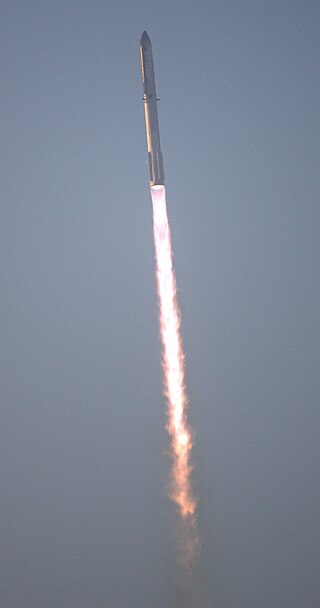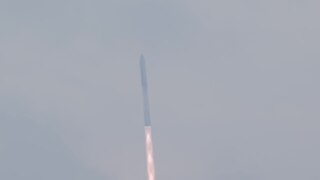
A reusable launch vehicle has parts that can be recovered and reflown, while carrying payloads from the surface to outer space. Rocket stages are the most common launch vehicle parts aimed for reuse. Smaller parts such as rocket engines and boosters can also be reused, though reusable spacecraft may be launched on top of an expendable launch vehicle. Reusable launch vehicles do not need to make these parts for each launch, therefore reducing its launch cost significantly. However, these benefits are diminished by the cost of recovery and refurbishment.

SpaceX has privately funded the development of orbital launch systems that can be reused many times, similar to the reusability of aircraft. SpaceX has developed technologies over the last decade to facilitate full and rapid reuse of space launch vehicles. The project's long-term objectives include returning a launch vehicle first stage to the launch site within minutes and to return a second stage to the launch pad, following orbital realignment with the launch site and atmospheric reentry in up to 24 hours. SpaceX's long term goal would have been reusability of both stages of their orbital launch vehicle, and the first stage would be designed to allow reuse a few hours after return. Development of reusable second stages for Falcon 9 was later abandoned in favor of developing Starship, however, SpaceX developed reusable payload fairings for the Falcon 9.

Starbase is an industrial complex for Starship rockets, located near Brownsville, Texas, United States. It has been under construction since the late 2010s by SpaceX, an American aerospace manufacturer. Starbase is composed of a spaceport near the Gulf of Mexico, a production facility at the Boca Chica village, and a small structure test site along the Texas State Highway 4.

The Falcon 9 first-stage landing tests were a series of controlled-descent flight tests conducted by SpaceX between 2013 and 2016. Since 2017, the first stage of Falcon 9 missions has been routinely landed if the rocket performance allowed it, and if SpaceX chose to recover the stage.

An autonomous spaceport drone ship (ASDS) is an ocean-going vessel derived from a deck barge, outfitted with station-keeping engines and a large landing platform, and is autonomously positioned when on station for a landing. Construction of the drone ships was commissioned by aerospace company SpaceX to allow recovery of launch vehicle boosters at sea for missions that do not carry sufficient fuel to return to the launch site after boosting spacecraft onto an orbital or interplanetary trajectory.

A super heavy-lift launch vehicle is a rocket that can lift to low Earth orbit a "super heavy payload", which is defined as more than 50 metric tons (110,000 lb) by the United States and as more than 100 metric tons (220,000 lb) by Russia. It is the most capable launch vehicle classification by mass to orbit, exceeding that of the heavy-lift launch vehicle classification.

Falcon 9 B1046 was a reusable Falcon 9 first-stage booster manufactured by SpaceX. It flew four times between 2018 and 2020 before it was expended during a successful abort test of the Crew Dragon. It was the first rocket of the final Falcon 9 upgrade, Block 5.

Starship is a two-stage super heavy-lift launch vehicle under development by SpaceX. As of May 2024, it is the largest and most powerful rocket ever flown. Starship's primary objective is to lower launch costs significantly via economies of scale. This is achieved by reusing both rocket stages, increasing payload mass to orbit, increasing launch frequency, creating a mass-manufacturing pipeline, and adapting it to a wide range of space missions. Starship is the latest project in SpaceX's decades-long reusable launch system development program and ambition of colonizing Mars.

Falcon 9 booster B1048 was a reusable orbital-class Block 5 Falcon 9 first-stage booster manufactured by SpaceX. B1048 was the third Falcon 9 Block 5 to fly and the second Block 5 booster to re-fly. It became the second orbital-class booster to fly a third time and is the first booster ever to be launched five times. B1048 service came to an end on its fifth flight when an engine shut down prematurely on launch. Whilst the primary mission was unaffected and the Starlink payload deployed successfully, B1048 was unable to land. In a subsequent investigation, SpaceX found that isopropyl alcohol, used as cleaning fluid, was trapped and ignited causing the engine to be shut down. To address the issue, in a following launch SpaceX indicated that the cleaning process was not done.
SpaceX Starship flight tests include fourteen launches of prototype rockets during 2019–2024 for the SpaceX Starship launch vehicle development program. Eleven test flights were of single-stage Starship spacecraft flying low-altitude tests (2019–2021), while three were orbital trajectory flights of the entire Starship launch vehicle (2023–2024), consisting of a Starship spacecraft second-stage prototype atop a Super Heavy first-stage booster prototype. None of the flights to date has carried an operational payload. More flight tests are planned in 2024 and 2025.
A floating launch vehicle operations platform is a marine vessel used for launch or landing operations of an orbital launch vehicle by a launch service provider: putting satellites into orbit around Earth or another celestial body, or recovering first-stage boosters from orbital-class flights by making a propulsive landing on the platform.

SpaceX Starship integrated flight test 1 (IFT-1) was the first integrated flight test of the SpaceX Starship launch vehicle. SpaceX performed the flight test on April 20, 2023. The prototype vehicle was destroyed less than four minutes after lifting off from the SpaceX Starbase in Boca Chica, Texas. The vehicle became the most powerful rocket ever flown, breaking the half-century-old record held by the Soviet Union's N1 rocket.

Super Heavy is the first stage of the SpaceX Starship super heavy-lift launch vehicle, which it composes in combination with the Starship second-stage. As of 2024, Super Heavy prototypes are being flight tested. Super Heavy flew for the first time on April 20, 2023, during the first orbital launch attempt of the Starship rocket.

Starship is a spacecraft and second stage under development by American aerospace company SpaceX. Stacked atop its booster, Super Heavy, it composes the identically named Starship super heavy-lift space vehicle. The spacecraft is designed to transport both crew and cargo to a variety of destinations, including Earth orbit, the Moon, Mars, and beyond. It is intended to enable long duration interplanetary flights for a crew of up to 100 people. It will also be capable of point-to-point transport on Earth, enabling travel to anywhere in the world in less than an hour. Furthermore, the spacecraft will be used to refuel other Starship vehicles to allow them to reach higher orbits and other space destinations. Elon Musk, the CEO of SpaceX, estimated in a tweet that 8 launches would be needed to completely refuel a Starship in low Earth orbit, extrapolating this from Starship's payload to orbit and how much fuel a fully fueled Starship contains. To land on bodies without an atmosphere, such as the Moon, Starship will fire its engines and thrusters to slow down.

SpaceX Starship Integrated Flight Test 2 (IFT-2) was the second integrated flight test of SpaceX Starship launch vehicle. SpaceX performed the flight test on November 18, 2023. The mission's primary objectives were for the vehicle to hot stage—a new addition to Starship's flight profile—followed by the second stage attaining a near-orbital trajectory with a controlled reentry over the Pacific Ocean, while the booster does a boostback burn with a propulsive splashdown in the Gulf of Mexico.

SpaceX Starship integrated flight test 3 (IFT-3) was the third integrated flight test of the SpaceX Starship launch vehicle. SpaceX performed the flight test on March 14, 2024.
SpaceX Starship integrated flight test 5 (IFT-5) will be the fifth integrated flight test of a prototype Starship launch vehicle. The prototype vehicles planned to be flown are the Ship 30 upper-stage and Booster 12.












